Impact of Urbanization on Ecosystem Health: A Case Study in Zhuhai, China
Abstract
1. Introduction
2. Materials and Methods
2.1. Study Area and Data Source
2.1.1. Study Area
2.1.2. Data Source
2.2. Assessment of Ecosystem Health
2.3. Quantifying Ecosystem Services
2.4. Mapping Urbanization Levels
2.5. Spatial Correlation Test
3. Results
3.1. Assessment of Urban Ecosystem Health
3.2. Spatial Distribution of Three Kinds of Urbanization Level
3.3. Effect of Urbanization on Urban Ecosystem Health
3.4. Spatial Dependence of ESH on Urbanization
4. Discussion
4.1. ESH in Zhuhai City Changed from 1999 to 2013
4.2. Spatial Spillover Effect in the Relationship between ESH and Urbanization
4.3. Better Management of the Urban Ecological Environment by Incorporating the Spatial Relationship between ESH and Urbanization
5. Conclusions
Author Contributions
Funding
Acknowledgments
Conflicts of Interest
References
- Li, Y.; Li, Y.; Zhou, Y.; Shi, Y.; Zhu, X. Investigation of a coupling model of coordination between urbanization and the environment. J. Environ. Manag. 2012, 98, 127–133. [Google Scholar] [CrossRef] [PubMed]
- Gu, C.; Hu, L.; Cook, I.G. China’s urbanization in 1949–2015: Processes and driving forces. Chin. Geogr. Sci. 2017, 27, 847–859. [Google Scholar] [CrossRef]
- Cao, H.; Liu, J.; Fu, C.; Zhang, W.; Wang, G.; Yang, G.; Luo, L. Urban Expansion and Its Impact on the Land Use Pattern in Xishuangbanna since the Reform and Opening up of China. Remote Sens. 2017, 9, 137. [Google Scholar] [CrossRef]
- Lv, J.; Yang, B.D.; Yang, Y.J.; Zhang, Z.H.; Chen, F.; Liu, G.J. Spatial Patterns of China’s Major Cities and Their Evolution Mechanisms during the Past Decades of Reform and Opening Up. Procedia Eng. 2017, 198, 915–925. [Google Scholar] [CrossRef]
- Weng, Q. A remote sensing? GIS evaluation of urban expansion and its impact on surface temperature in the Zhujiang Delta, China. Int. J. Remote Sens. 2001, 22, 1999–2014. [Google Scholar] [CrossRef]
- Shao, X.; Jing, C.; Qi, J.; Jiang, J.; Liu, Q.; Cai, X. Impacts of land use and planning on island ecosystem service values: A case study of Dinghai District on Zhoushan Archipelago, China. Ecol. Process. 2017, 6. [Google Scholar] [CrossRef]
- Wang, W.; Zhang, X.; Wu, Y.; Zhou, L.; Skitmore, M. Development priority zoning in China and its impact on urban growth management strategy. Cities 2017, 62, 1–9. [Google Scholar] [CrossRef]
- Huang, S.; Wang, M.; Wu, J.; Li, Q.; Yang, J.; Guo, L.; Wang, J.; Xu, Z. The exploration and practice on soil environmental protection in the process of rapid urbanization of the megacity Shanghai. In Twenty Years of Research and Development on Soil Pollution and Remediation in China; Springer: Singapore, 2018; pp. 133–147. [Google Scholar] [CrossRef]
- Lin, B.; Zhu, J. Changes in urban air quality during urbanization in China. J. Clean. Prod. 2018, 188, 312–321. [Google Scholar] [CrossRef]
- Huang, G.; Zhou, W.; Cadenasso, M.L. Is everyone hot in the city? Spatial pattern of land surface temperatures, land cover and neighborhood socioeconomic characteristics in Baltimore, MD. J Environ. Manag. 2011, 92, 1753–1759. [Google Scholar] [CrossRef]
- Leopold, A. Wilderness as a land laboratory. Living Wilderness 1941, 6, 3. [Google Scholar]
- Rapport, D.J. Evaluating ecosystem health. J. Aquat. Ecosyst. Health 1992, 1, 15–24. [Google Scholar] [CrossRef]
- Su, M.; Fath, B.D.; Yang, Z. Urban ecosystem health assessment: A review. Sci. Total Environ. 2010, 408, 2425–2434. [Google Scholar] [CrossRef] [PubMed]
- Su, M.; Xie, H.; Yue, W.; Zhang, L.; Yang, Z.; Chen, S. Urban ecosystem health evaluation for typical Chinese cities along the Belt and Road. Ecol. Indic. 2019, 101, 572–582. [Google Scholar] [CrossRef]
- Wilkins, D. Assessing ecosystem health. Trends Ecol. Evol. 1999, 14, 69. [Google Scholar] [CrossRef]
- Odum, E.P.; Finn, J.T.; Franz, E.H. Perturbation Theory and the Subsidy-Stress Gradient. BioScience 1979, 29, 349–352. [Google Scholar] [CrossRef]
- Rapport, D.J. What constitute ecosystem health? Perspect. Biol. Med. 1989, 33, 120–132. [Google Scholar] [CrossRef]
- Schaeffer, D.J.; Herricks, E.E.; Kerster, H.W. Ecosystem health: I. Measuring ecosystem health. Environ. Manag. 1988, 12, 445–455. [Google Scholar] [CrossRef]
- Su, M.R.; Yang, Z.F.; Chen, B. Set pair analysis for urban ecosystem health assessment. Commun. Nonlinear Sci. Numer. Simul. 2009, 14, 1773–1780. [Google Scholar] [CrossRef]
- Costanza, R. Toward an operational definition of ecosystem health. Ecosyst. Health: New Goals Environ. Manag. 1992, 239–256. [Google Scholar]
- Peng, J.; Wang, Y.; Wu, J.; Zhang, Y. Evaluation for regional ecosystem health: Methodology and research progress. Acta Ecol. Sin. 2007, 27, 4877–4885. [Google Scholar] [CrossRef]
- Costanza, R. Ecosystem health and ecological engineering. Ecol. Eng. 2012, 45, 24–29. [Google Scholar] [CrossRef]
- Liao, C.; Yue, Y.; Wang, K.; Fensholt, R.; Tong, X.; Brandt, M. Ecological restoration enhances ecosystem health in the karst regions of southwest China. Ecol. Indic. 2018, 90, 416–425. [Google Scholar] [CrossRef]
- Van Niekerk, L.; Adams, J.B.; Bate, G.C.; Forbes, A.T.; Forbes, N.T.; Huizinga, P.; Lamberth, S.J.; MacKay, C.F.; Petersen, C.; Taljaard, S.; et al. Country-wide assessment of estuary health: An approach for integrating pressures and ecosystem response in a data limited environment. Estuar. Coast. Shelf Sci. 2013, 130, 239–251. [Google Scholar] [CrossRef]
- Peng, J.; Liu, Y.; Wu, J.; Lv, H.; Hu, X. Linking ecosystem services and landscape patterns to assess urban ecosystem health: A case study in Shenzhen City, China. Landsc. Urban Plan. 2015, 143, 56–68. [Google Scholar] [CrossRef]
- He, J.; Pan, Z.; Liu, D.; Guo, X. Exploring the regional differences of ecosystem health and its driving factors in China. Sci Total Environ. 2019, 673, 553–564. [Google Scholar] [CrossRef]
- Sun, R.; Yao, P.; Wang, W.; Yue, B.; Liu, G. Assessment of Wetland Ecosystem Health in the Yangtze and Amazon River Basins. ISPRS Int. J. Geo-Inf. 2017, 6, 81. [Google Scholar] [CrossRef]
- Wang, Z.; Tang, L.; Qiu, Q.; Chen, H.; Wu, T.; Shao, G. Assessment of Regional Ecosystem Health-A Case Study of the Golden Triangle of Southern Fujian Province, China. Int. J. Environ. Res Public Health 2018, 15, 802. [Google Scholar] [CrossRef]
- Zhang, Y.; Liu, Y.; Zhang, Y.; Liu, Y.; Zhang, G.; Chen, Y. On the spatial relationship between ecosystem services and urbanization: A case study in Wuhan, China. Sci. Total Env. 2018, 637–638, 780–790. [Google Scholar] [CrossRef]
- Ludwig, J.A.; Bastin, G.N.; Chewings, V.H.; Eager, R.W.; Liedloff, A.C. Leakiness: A new index for monitoring the health of arid and semiarid landscapes using remotely sensed vegetation cover and elevation data. Ecol. Indic. 2007, 7, 442–454. [Google Scholar] [CrossRef]
- Kerr, J.T.; Ostrovsky, M. From space to species: Ecological applications for remote sensing. Trends Ecol. Evol. 2003, 18, 299–305. [Google Scholar] [CrossRef]
- Sheng, N.; Tang, U.W. Zhuhai. Cities 2013, 32, 70–79. [Google Scholar] [CrossRef]
- Shin, H.B. Economic transition and speculative urbanisation in China: Gentrification versus dispossession. Urban Stud. 2015, 53, 471–489. [Google Scholar] [CrossRef]
- Zhang, X.; Du, S.; Wang, Y.C. Semantic Classification of Heterogeneous Urban Scenes Using Intrascene Feature Similarity and Interscene Semantic Dependency. IEEE J. Sel. Top. Appl. Earth Obs. Remote Sens. 2015, 8, 2005–2014. [Google Scholar] [CrossRef]
- National Science and Technology Infrastructure of China. Available online: http://www.geodata.cn (accessed on 15 January 2019).
- Box, E.O.; Holben, B.N.; Kalb, V. Accuracy of the AVHRR vegetation index as a predictor of biomass, primary productivity and net CO2 flux. Vegetation 1989, 80, 71–89. [Google Scholar] [CrossRef]
- Nemani, R.R.; Keeling, C.D.; Hirofumi, H.; Jolly, W.M.; Piper, S.C.; Tucker, C.J.; Myneni, R.B.; Running, S.W. Climate-driven increases in global terrestrial net primary production from 1982 to 1999. Science 2003, 300, 1560–1563. [Google Scholar] [CrossRef]
- Masek, J.G. Stability of Boreal Forest Stands during Recent Climate Change: Evidence from Landsat Satellite Imagery. J. Biogeogr. 2001, 28, 967–976. [Google Scholar] [CrossRef]
- Scanlon, T.M.; Albertson, J.D.; Caylor, K.K.; Williams, C.A. Determining land surface fractional cover from NDVI and rainfall time series for a savannaecosystem. Remote Sens. Environ. 2002, 82, 376–388. [Google Scholar] [CrossRef]
- Peterson, G.D. Contagious Disturbance, Ecological Memory, and the Emergence of Landscape Pattern. Ecosystems 2002, 5, 329–338. [Google Scholar] [CrossRef]
- Turner, M.G. Landscape ecology: The effect of pattern on process. Annu. Rev. Ecol. Syst. 1989, 20, 171–197. [Google Scholar] [CrossRef]
- Costanza, R.; d’Arge, R.; de Groot, R.; Farber, S.; Grasso, M.; Hannon, B.; Limburg, K.; Naeem, S.; O’Neill, R.V.; Paruelo, J.; et al. The value of the world’s ecosystem services and natural capital. Nature 1997, 387, 253–260. [Google Scholar] [CrossRef]
- Xie, G.; Zhang, C.; Zhen, L.; Zhang, L. Dynamic changes in the value of China’s ecosystem services. Ecosyst. Serv. 2017, 26, 146–154. [Google Scholar] [CrossRef]
- National Library of China official website. Available online: http://www.nlc.cn (accessed on 26 02 2019).
- Peng, J.; Liu, Y.; Li, T.; Wu, J. Regional ecosystem health response to rural land use change: A case study in Lijiang City, China. Ecol. Indic. 2017, 72, 399–410. [Google Scholar] [CrossRef]
- Xiao, R.; Yu, X.; Shi, R.; Zhang, Z.; Yu, W.; Li, Y.; Chen, G.; Gao, J. Ecosystem health monitoring in the Shanghai-Hangzhou Bay Metropolitan Area: A hidden Markov modeling approach. Env. Int. 2019, 133, 105170. [Google Scholar] [CrossRef] [PubMed]
- Su, S.; Rui, X.; Jiang, Z.; Yuan, Z. Characterizing landscape pattern and ecosystem service value changes for urbanization impacts at an eco-regional scale. Appl. Geogr. 2012, 34, 295–305. [Google Scholar] [CrossRef]
- Wu, J.; Ma, L.; Li, W.; Peng, J.; Liu, H. Dynamics of Urban Density in China: Estimations Based on DMSP/OLS Nighttime Light Data. IEEE J. Sel. Top. Appl. Earth Obs. Remote Sens. 2017, 7, 4266–4275. [Google Scholar] [CrossRef]
- Wan, L.; Ye, X.; Lee, J.; Lu, X.; Lan, Z.; Wu, K. Effects of urbanization on ecosystem service values in a mineral resource-based city. Habitat Int. 2015, 46, 54–63. [Google Scholar] [CrossRef]
- Anselin, L.; Rey, S.J. Modern Spatial Econometrics in Practice; GeoDa Press LLC: Chicago, IL, USA, 2014. [Google Scholar] [CrossRef]
- Fei, L.; Zhou, C. Spatial Autocorrelation Analysis on Regional Economic Disparity of Northeast Economic Region in China. Chin. J. Popul. Resour. Environ. 2009, 7, 27–31. [Google Scholar] [CrossRef]
- Anselin, L. Local Indicators of Spatial Association—LISA. Geogr. Anal. 1995, 27, 93–115. [Google Scholar] [CrossRef]
- Wang, S.H.; Huang, S.-L.; Budd, W.W. Integrated ecosystem model for simulating land use allocation. Ecol. Model. 2012, 227, 46–55. [Google Scholar] [CrossRef]
- Zeng, C.; Deng, X.; Xu, S.; Wang, Y.; Cui, J. An integrated approach for assessingthe urban ecosystem health of megacities in China. Cities 2016, 53, 110–119. [Google Scholar] [CrossRef]
- Wu, L.Y.; You, W.B.; Ji, Z.R.; Xiao, S.H.; He, D.J. Ecosystem health assessment ofDongshan Island based on its ability to provide ecological services that regulateheavy rainfall. Ecol. Indic. 2018, 84, 393–403. [Google Scholar] [CrossRef]
- Burkhard, B.; Kandziora, M.; Hou, Y.; Müller, F. Ecosystem service potentials, flows and demands-concepts for spatial localisation, indication and quantification. Landsc. Online 2014, 34, 1–32. [Google Scholar] [CrossRef]
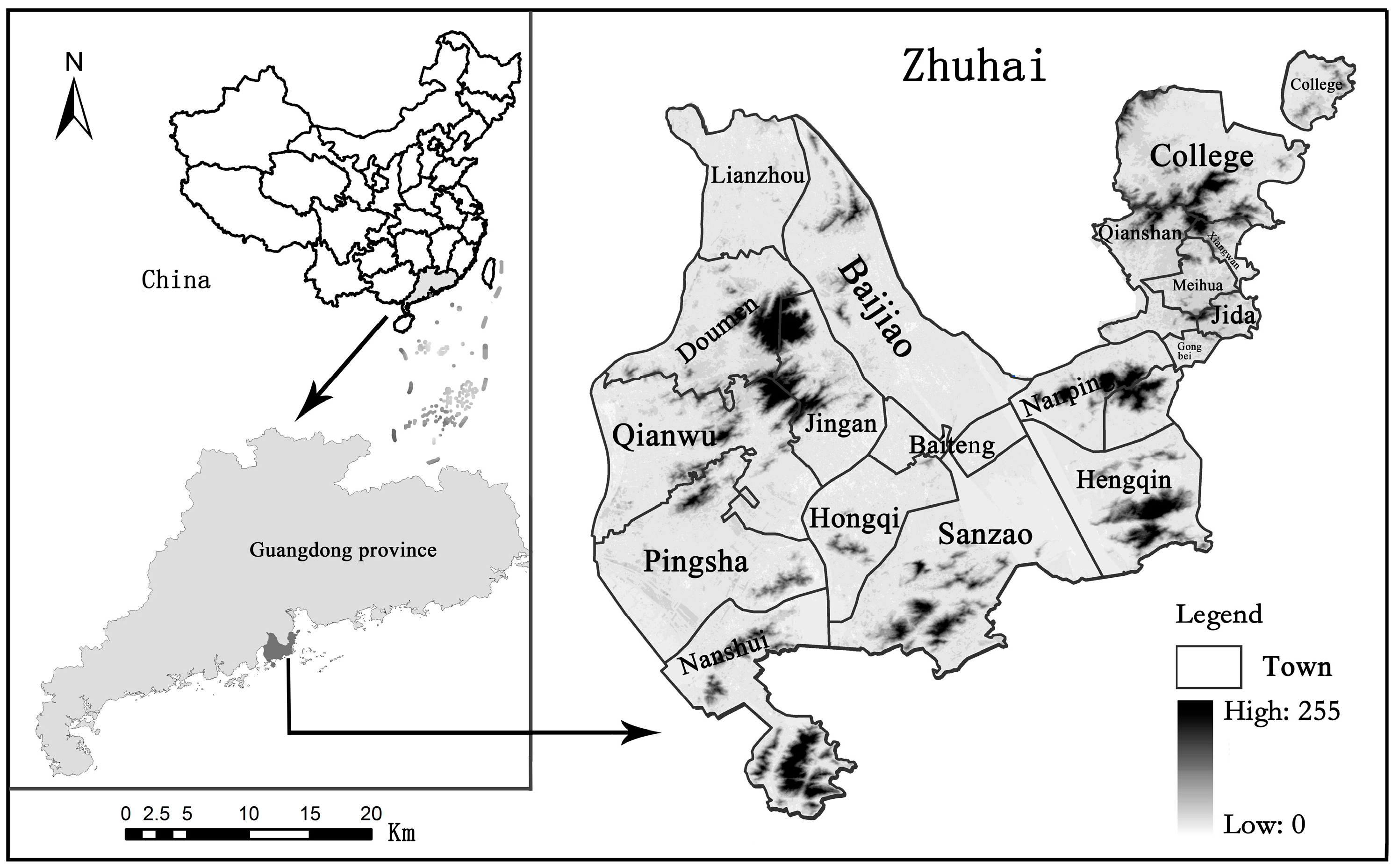
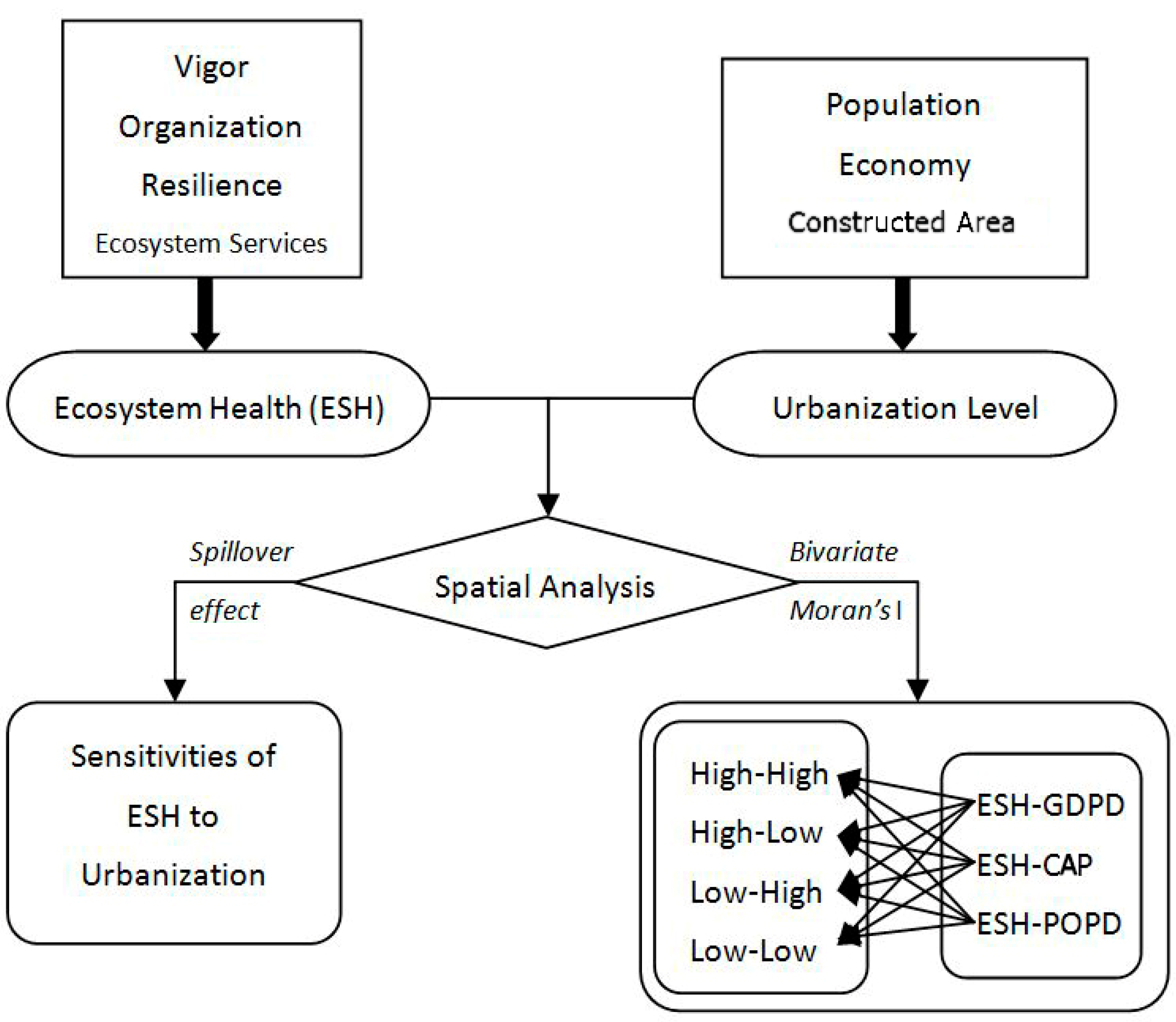
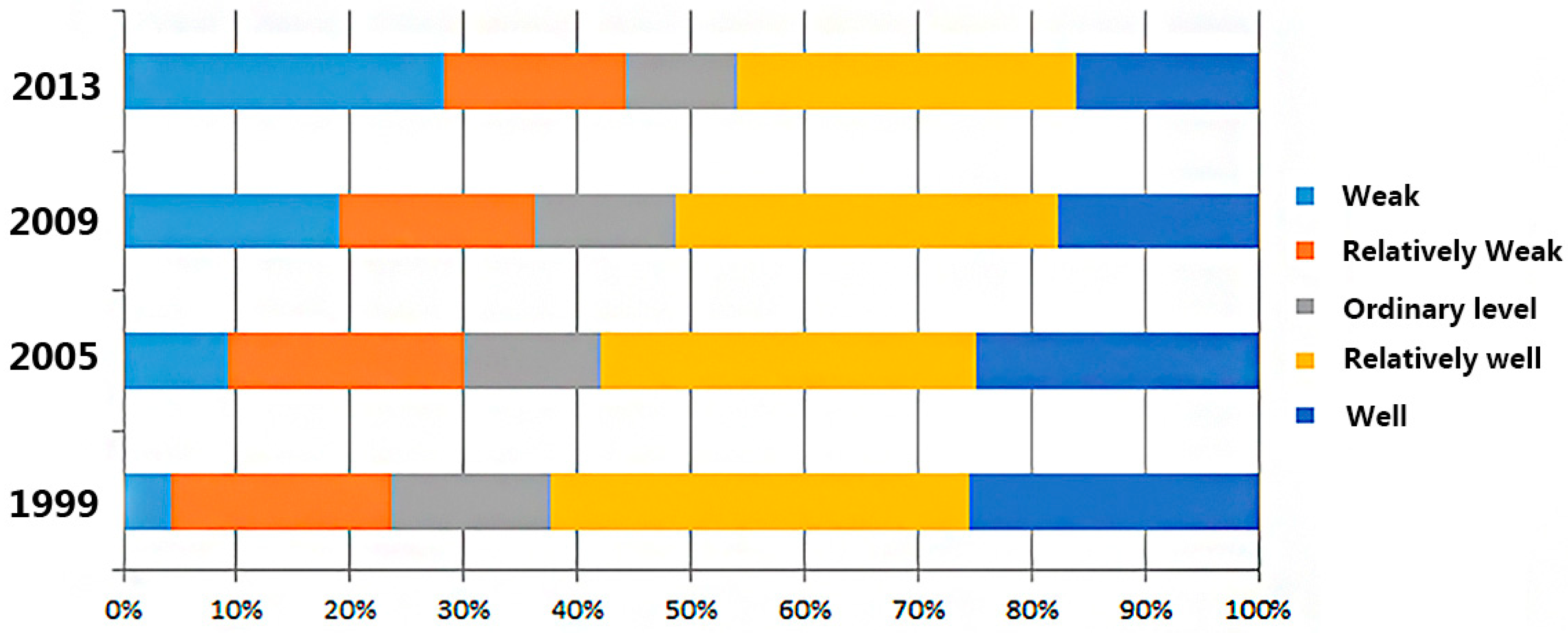
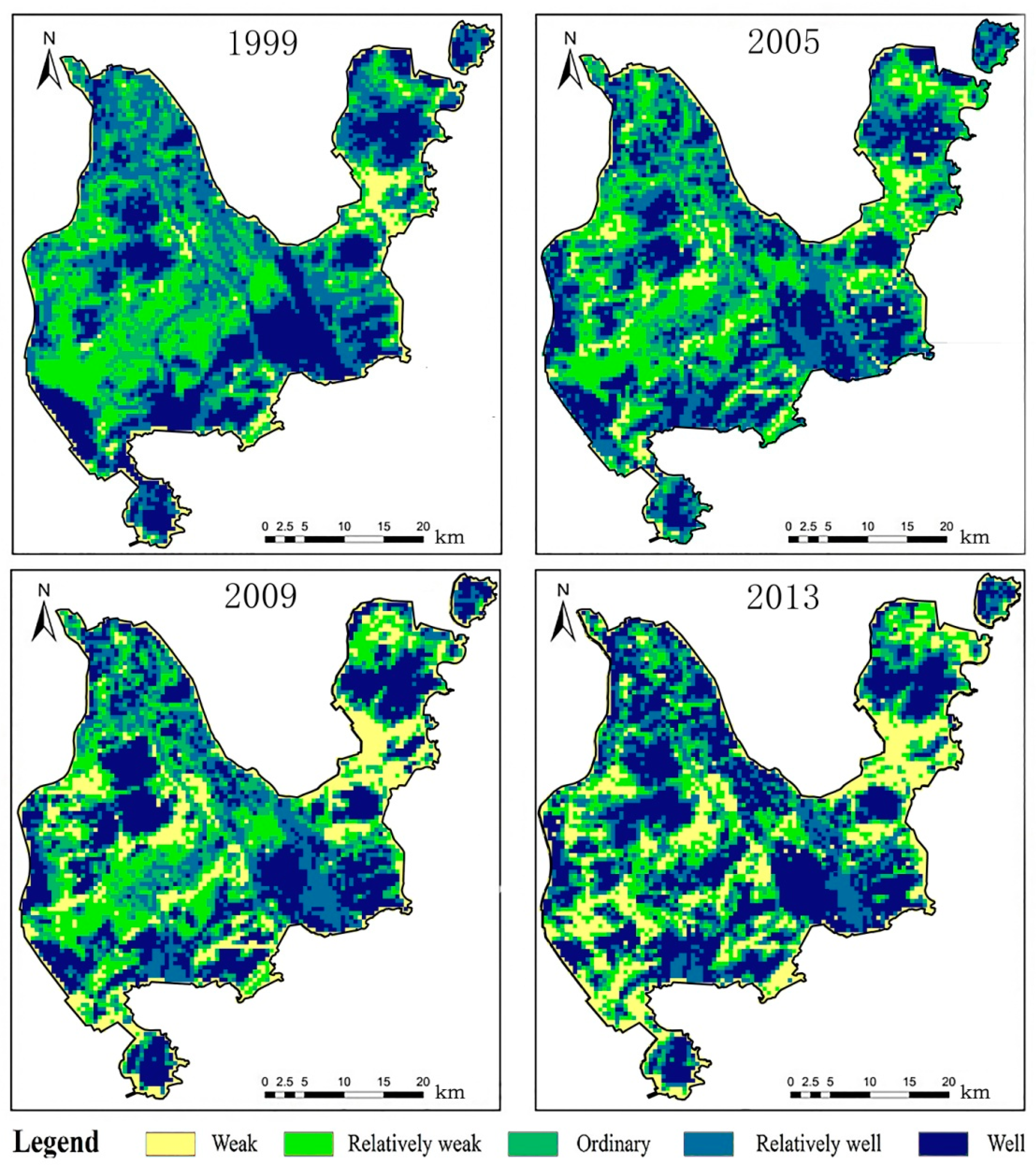
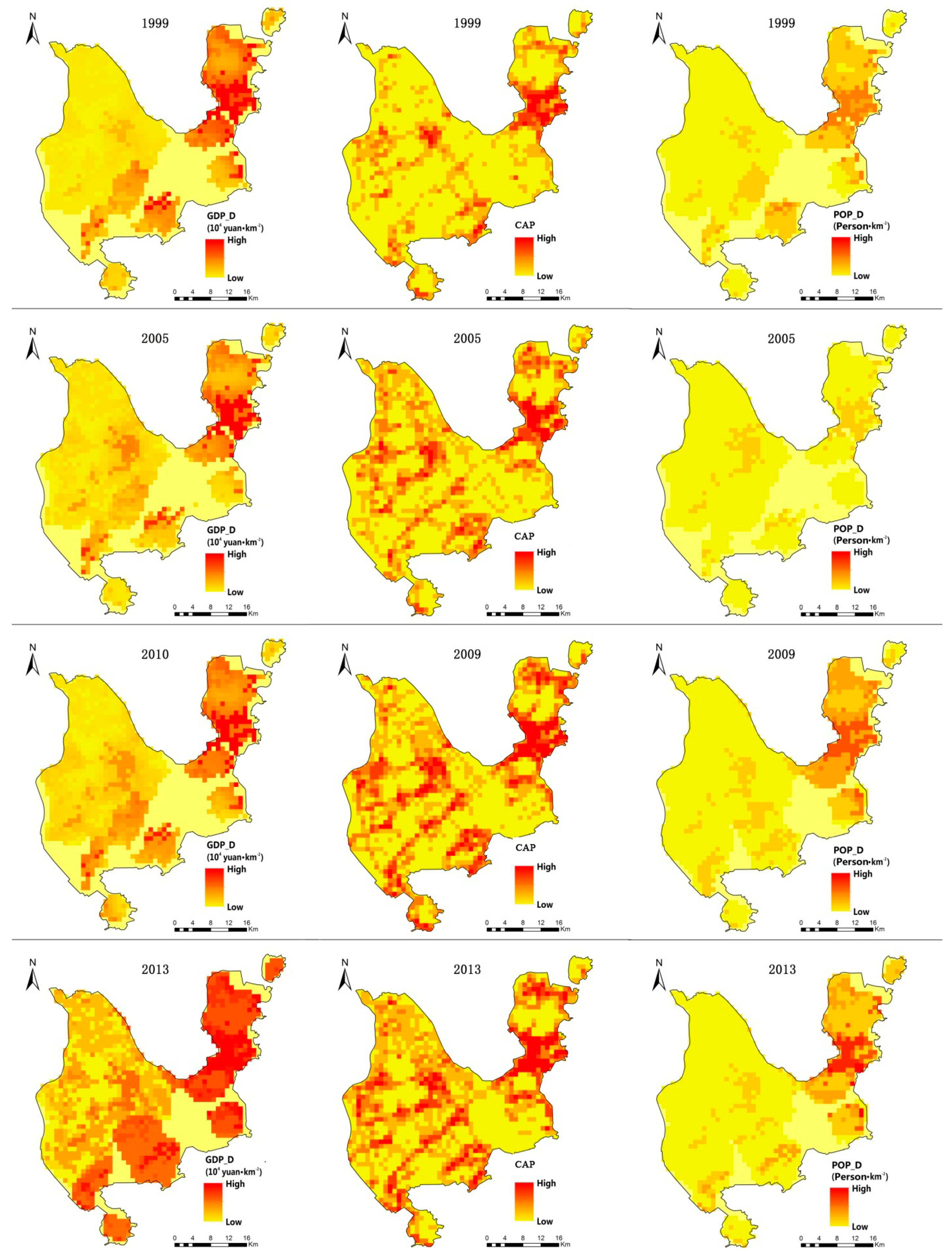
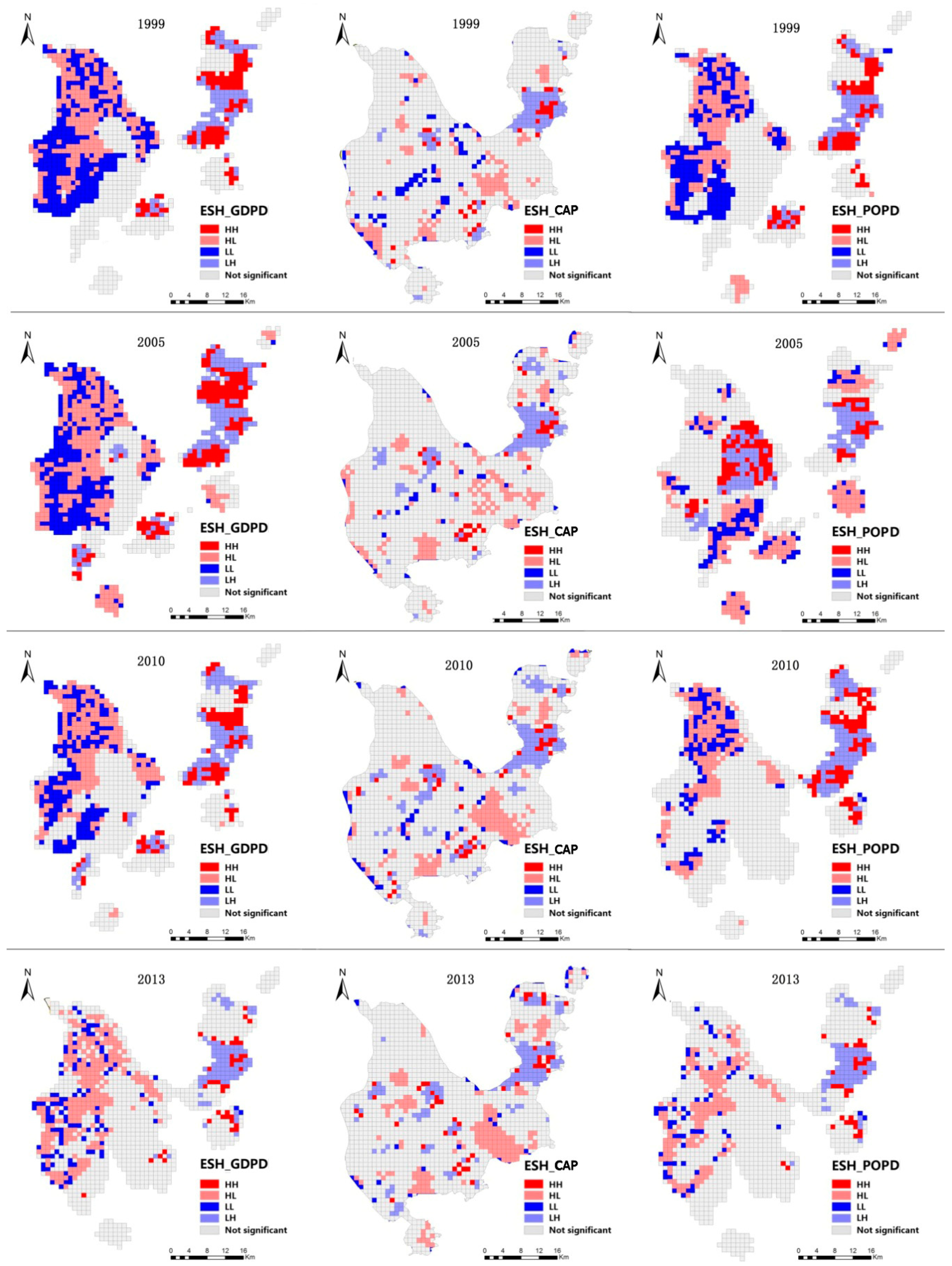
| IUL | Year | 1999 | 2005 | 2009 | 2013 |
|---|---|---|---|---|---|
| GDPD | Moran’s I | –0.0484 | –0.1198 | –0.1477 | –0.2463 |
| z-Value | –4.107 | –19.84 | –12.66 | –15.64 | |
| p-Value | 0.001 | 0.001 | 0.001 | 0.001 | |
| POPD | Moran’s I | –0.0883 | –0.1654 | –0.1255 | –0.2619 |
| z-Value | –7.516 | –26.04 | –8.322 | –16.49 | |
| p-Value | 0.001 | 0.001 | 0.001 | 0.001 | |
| CAP | Moran’s I | –0.2039 | –0.2001 | –0.2738 | –0.257 |
| z-Value | –15.99 | –15.87 | –21.18 | –19.66 | |
| p-Value | 0.001 | 0.001 | 0.001 | 0.001 |
| Dependent | ESH1999 | ESH2005 | ESH2009 | ESH2013 |
|---|---|---|---|---|
| Constant | 0.50621 | 0.620177 | 0.664083 ** | –82.5178 |
| GDPD | 0.195904 ** | 0.148384 | 0.120648 * | –159.412 |
| POPD | –0.00491 | –0.159545 | 0.168452 ** | –438.546 |
| CAP | –0.757281 ** | –0.656092 | –0.945341 ** | 173.391 |
| R2 | 0.199883 | 0.242939 | 0.389663 | 0.005089 |
| Log likelihood | 165.233 | 176.358 | –34.5155 | –11255.2 |
| AIC | –322.465 | –344.716 | 77.0309 | 22518.5 |
| SC | 302.395 | –324.53 | 96.992 | 22539.3 |
| Moran’s I | 20.7746 ** | 11.9284 ** | 18.0845 ** | 9.1422 ** |
| Lagrange multiplier (lag) | 367.6217 ** | 127.6153 ** | 262.6840 ** | 79.0298 ** |
| Robust LM (lag) | 1.0614 | 2.51 | 6.4710 * | 0.1599 |
| Lagrange multiplier (error) | 419.5618 ** | 136.4934 ** | 316.9356 ** | 79.6533 ** |
| Robust LM (error) | 53.0015 | 11.3888 ** | 60.7225 ** | 0.7833 |
| Dependent variables | ESH1999 | ESH2005 | ESH2009 | ESH2013 |
|---|---|---|---|---|
| LAMBDA | 0.613031 ** | 0.420321 ** | 0.563871 ** | 0.425095 ** |
| Constant | 0.517883 | 0.611472 ** | 0.660955 ** | –110.963 |
| GDPD | 0.113996 ** | 0.133592 ** | 0.094901 | –130.042 |
| POPD | –0.00579 | –0.148248 ** | 0.140503 * | –557.4 |
| CAP | –0.747333 ** | –0.626769 ** | –0.888831 ** | 250.482 |
| R2 | 0.415862 | 0.325404 | 0.524507 | 0.089752 |
| Log likelihood | 300.803312 | 225.35109 | 69.3103 | –11215.7 |
| AIC | –593.607 | –422.702 | –130.621 | 22439.3 |
| SC | –573.537 | –422.516 | –110.66 | 22460.1 |
© 2019 by the authors. Licensee MDPI, Basel, Switzerland. This article is an open access article distributed under the terms and conditions of the Creative Commons Attribution (CC BY) license (http://creativecommons.org/licenses/by/4.0/).
Share and Cite
Cui, N.; Feng, C.-C.; Han, R.; Guo, L. Impact of Urbanization on Ecosystem Health: A Case Study in Zhuhai, China. Int. J. Environ. Res. Public Health 2019, 16, 4717. https://doi.org/10.3390/ijerph16234717
Cui N, Feng C-C, Han R, Guo L. Impact of Urbanization on Ecosystem Health: A Case Study in Zhuhai, China. International Journal of Environmental Research and Public Health. 2019; 16(23):4717. https://doi.org/10.3390/ijerph16234717
Chicago/Turabian StyleCui, Nan, Chen-Chieh Feng, Rui Han, and Luo Guo. 2019. "Impact of Urbanization on Ecosystem Health: A Case Study in Zhuhai, China" International Journal of Environmental Research and Public Health 16, no. 23: 4717. https://doi.org/10.3390/ijerph16234717
APA StyleCui, N., Feng, C.-C., Han, R., & Guo, L. (2019). Impact of Urbanization on Ecosystem Health: A Case Study in Zhuhai, China. International Journal of Environmental Research and Public Health, 16(23), 4717. https://doi.org/10.3390/ijerph16234717






